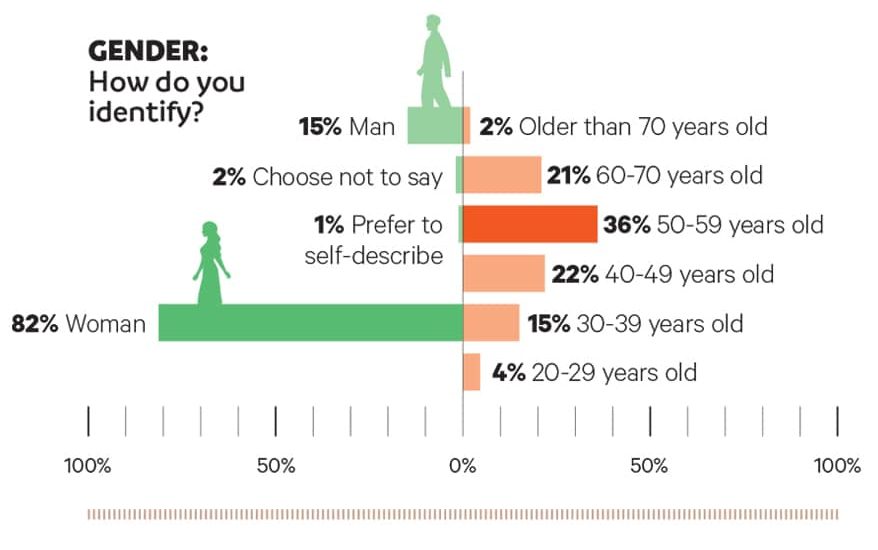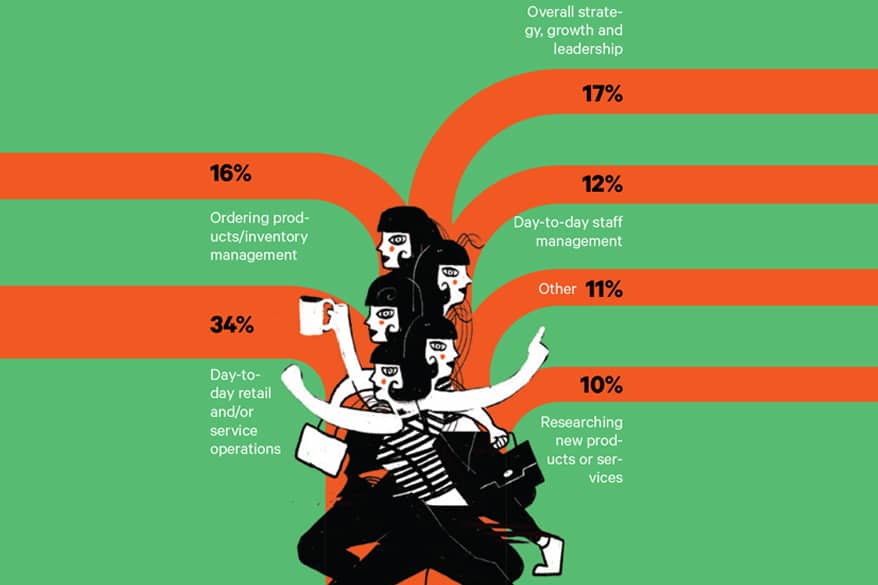Let’s take a closer look at the pet business owners and full-time top managers who took our Big Survey — who you are, what you believe, and how you manage the many demands on your time.
What is your age range?

RACE OR ETHNICITY: How do you identify?
| American Indian or Alaskan Native |
|
1%
|
| Asian |
|
2%
|
Black or African
American |
|
1%
|
| Hispanic or Latino |
|
2%
|
| Multiracial |
|
2%
|
| White |
|
87%
|
| Choose not to say |
|
5%
|
Breaking your work week into percentages, how do you split your time as a business owner or fulltime top manager?

Advertisement
What is something you believe about running a pet business that nearly no one else in the industry agrees with you on?
More than a few of you answered this question with “The customer is always right,” but just as many said, “The customer is not always right.” Only selling products you believe in also was mentioned multiple times, as was that it’s OK to compromise standards to meet customer demand. So we’ll call all of those commonly held beliefs, just by different groups of pet pros. Here are a few answers, though, that spark debate most of the time.
- That Amazon, big-box stores and Chewy are not the worst things to happen to the pet industry, and they are not a reason to discontinue a brand — a brand being in one of those channels does not mean it’s inherently bad.
- Paying a living wage is vital.
- If you offer an amazing customer experience and a dynamic product selection, you don’t have to sell online.
- The pet industry is not recession proof.
- There is no such thing as Positive Reinforcement-only training.
- It’s OK to not automate bookings and invoicing.
- People spend just as much money on their cats as they do their dogs. Stores fail to cater to cats equally, and as such the self-fulfilling prophecy of “people spend less on cats” comes true. People won’t spend as much on cats if they don’t have as much to choose from — it’s that simple.
- I enjoy helping my customers’ pets live a long and healthy life, even if that means discounting products so they can afford them.

- In a small town, location is overrated. We’re the only ones selling certain brands, and customers seek us out. I’m skeptical that there would be enough walk-in traffic to offset the difference in rent to move.
- Most supplements are wasteful.
- We pay our groomers 50% commission. Most people say it’s impossible to be a profitable business doing that.
- A POS system is nice but not crucial to running my business.
- Owners need to be in the store.

- That the love of animals is a small part of it. If that is all you have, get a job elsewhere and keep all the pets you desire. You need to have a wide set of business skills to succeed in this industry.
- We don’t use social media. We are organically grown with referrals.
- Pet is one of the easiest industries to excel in for a local brick-and-mortar store.
- I believe it is not only OK but necessary to have some polarizing opinions. Yes, you may lose some customers, but you can also gain raving fans that align with your beliefs.
What have you found hardest to balance in 2023?

How many hours per week do you work from home?
| 0 |
|
13%
|
| 1-5 |
|
20%
|
| 6-10 |
|
23%
|
| 11-15 |
|
13%
|
| 16-20 |
|
13%
|
| 21-25 |
|
5%
|
| More than 25 |
|
13%
|
In general, how many full days do you take off each week?
| 0 |
|
21%
|
| 1 |
|
35%
|
| 2 |
|
36%
|
| 3 |
|
6%
|
| 4 or more |
|
2%
|
The portion of business owners and full-time top managers who never take a full day off was quite alarming at 21%. And it isn’t the youngsters trying to build their businesses who won’t or can’t regularly take a break. Those ages 30 to 39 were actually the least likely to take no days off — they accounted for just 6% of all week-workers. Meanwhile, those ages 50 to 59 were the most likely to never take a day off, accounting for 40% of those working seven days a week. While alarming, in general, how these results break out demographically doesn’t surprise us too much, as younger generations tend to place a higher priority on achieving and maintaining a healthy work-life balance.
If you are the business owner, what is your exit strategy?
| To sell at a profit |
|
38%
|
To sell whether at a profit
or not |
|
6%
|
To leave the business to
family |
|
11%
|
| To close the business |
|
4%
|
| I have no exit strategy |
|
17%
|
| N/A |
|
15%
|
| Other (please specify) |
|
9%
|
Several of the “Other” answers involved gifting the business, but not to family. Long-term employees and a rescue were among the recipients of such generosity.
Advertisement
If you take off two or more days each week, how many years were you in business before you could?
| 1 |
|
16%
|
| 2 |
|
14%
|
| 3 |
|
9%
|
4 or more
years |
|
61%
|
If you are a parent with school-age or younger children, what is your best advice for achieving balance between work and family? Even if you don’t always follow it yourself.
Among the answersto this question were to rely on extended family and/or a nanny for support and to be fully staffed with competent employees. Easier said than done at times, we’re sure all business owners with kids would agree — even those who offered such advice. Here are other examples of what respondents said works now or has worked for them in the past.
RETHINK & STICK TO YOUR SCHEDULE
- Carve out time in your day to “unplug” and make sure employees know that at that time, you are unavailable unless it’s an emergency. For example, I am unavailable from 5 to 8 p.m. so I can have family time, dinner and bedtime.
- Last year, I switched to a 4/10 schedule. It has made a world of a difference in my relationship with my 4-yearold daughter.
- Opening a little later to spend the morning with my kids and closing early enough to spend time with them before bed.
- Being organized about dinner prep on the weekend helped clear up a lot of extra time each night because I knew what we were eating and had already prepped or had it in the slow cooker. Every Sunday, I shop and prep.
- If you’re not going to be with your kids when they get out of school, catch up as soon as possible. One of the favorite parts of my workday is when my son calls me on his way home from the bus stop.
- I decided to be closed on Sundays because it is the only day I can be with them, fully present, and enjoy a mental break from business.
UNPLUG & ENGAGE
- The best thing I did when fighting for balance in my life was taking all work email off my phone. If it happens outside of business hours, it will be fine to wait until the next day. Those who need to reach me if something is on fire and can’t wait, know my number.
- Give yourself a quitting time. When I simply allow my brain to know that work is over for the day, it helps me be more present with my kids. Otherwise, I could find stuff to do all night long.
- When you walk out the shop door to pick up the kids, leave it behind. When the kids go to bed, have that glass of wine, and then open the laptop to work.

TAKE YOUR KIDS TO WORK
- Homeschool your kids. Bring them to work as often as possible. They will learn a ton at the store, and there is plenty of time for them to do school work (in the office, where it’s quiet).
- Get them involved. Sometimes kids are the best at bouncing ideas off of!
- Teach your children the importance of patience. People approach me everywhere to ask about store-related things. My kids have learned to wait patiently. This lesson has proven to be a good one in their lives!